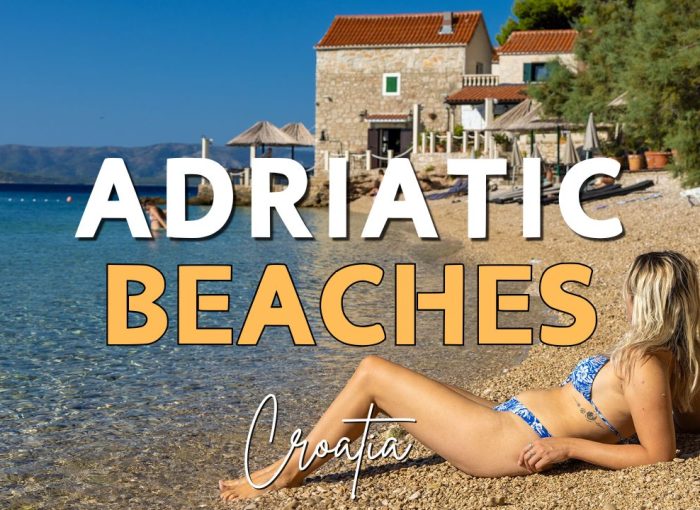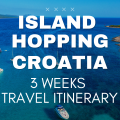With its crystal-clear waters and stunning coastal landscapes, Croatia’s Adriatic coast is a hidden gem for beach lovers. This Adriatic beaches guide will help you discover the best spots to soak up the sun along Croatia’s breathtaking shores.
Croatia’s Adriatic coast is a treasure trove of diverse and beautiful beaches, drawing visitors from around the globe with its pristine waters and impeccable standards. Some of these beaches are iconic, like Zlatni Rat, Stiniva or Sakarun, in a heavenly beautiful landscape setting, often with the backdrop of old stone towns.
Table of Contents
With over 6,000km of coastline and over 1,000 islands, many untouched by development, the country offers an unparalleled beach experience. The Adriatic Sea’s sparkling clear waters, combined with Croatia’s rich cultural heritage and natural beauty, make it a top destination for a family vacation, offering the best beaches for every type of traveller. From the historic towns of Dubrovnik and Split to the natural allure of secluded beaches and vibrant nightlife, the Adriatic coast is a perfect backdrop for a Croatia summer holiday.
Adriatic Coast of Croatia
The Adriatic Sea, with its crystal-clear waters akin to a swimming pool, is often hailed as the most splendid sea in Europe. The defining feature of the Adriatic coast is porous limestone rock, which is shaped by the elements in countless shapes and forms. The Adriatic Sea is characterised by its indented coastline and features numerous bays, coves, and inlets. These sedimentary rocks have been sculpted by erosion and weathering processes, giving rise to steep cliffs and rocky outcrops along the shoreline.
Pasjača Beach, south of Dubrovnik or Mali Bok on Cres Island, are hidden beneath cush towering rocks that protect it from people. The presence of these rocky formations has contributed to the creation of picturesque beaches and crystal-clear waters emblematic of the Adriatic coast. As a result, the Adriatic coast is predominantly rocky, with scattered pebble and sand beaches in smaller or larger coves.
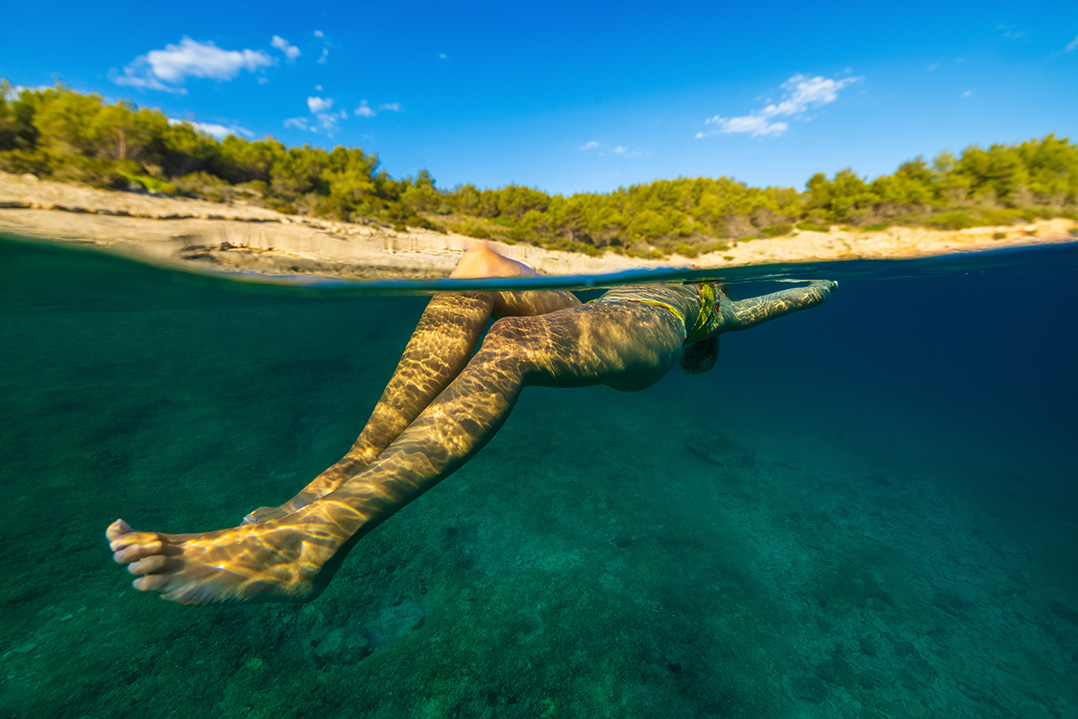
Usually, large bays combine all elements. Dugi Otok brings to the forefront Sakarun Beach, celebrated for its sandy seabed with shallow, turquoise waters, long pebble beach and the rocky, forested side of the coves, offering a stunning seascape and a natural respite from the sun.
Natural Paradise
Exploring the natural beaches along the Adriatic coast in Croatia reveals a world of untouched beauty and serene landscapes. This secluded paradise offers a tranquil escape from the bustling tourist spots, allowing visitors to immerse themselves in the calming sounds of the sea and the breathtaking views of the surrounding untouched landscapes.
The Croatian Adriatic coast offers postcard images of divine beaches bordered by dense pine and oak forests of Murter or dramatic barren landscapes of Pag.
The experience of swimming and snorkelling in a warm, crystal-clear sea, and sunbathing on rocks, pebbles, or sand while listening to the melodious chorus of cicadas under the shade of fragrant pine trees creates an image of paradise.
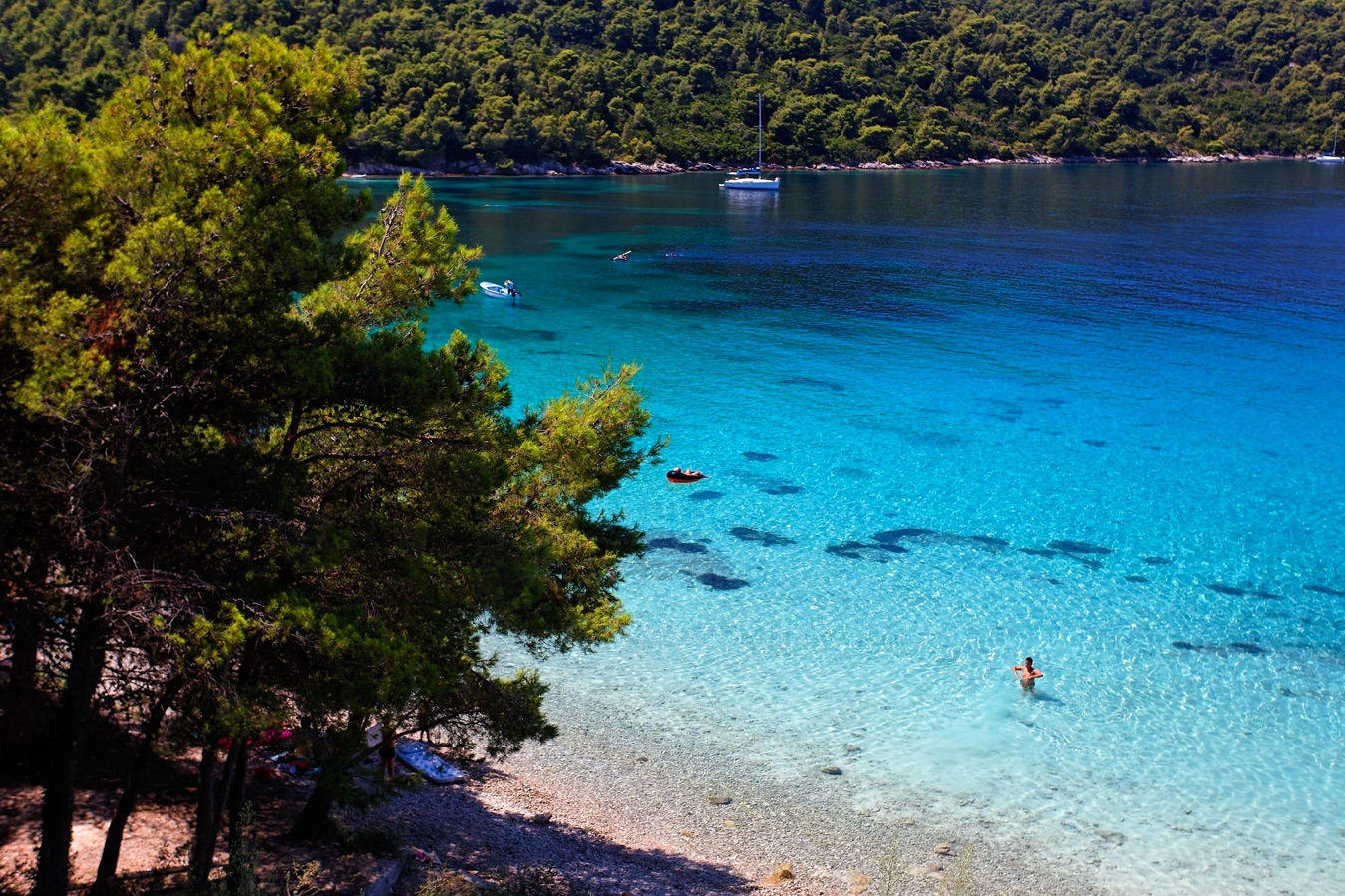
Many beaches are remote and far from the busy roads that bring crowds, pollution, and noise. Nugal Beach, for example, requires a half-hour walk from the bustling town of Makarska, making it a true oasis of nature. Fortunately, numerous natural beaches are just a short distance from popular and crowded destinations, often requiring only a brief stroll. If you’re an early riser, finding a secluded beach all to yourself is even easier.
Most of these natural beaches are located on sparsely populated islands and protected areas.
Lojena Beach, nestled in the Kornati National Park archipelago, stands out for its crystal-clear sea and pristine nature. Telašćica Nature Park on Dugi Otok is a must-visit. This nature park is home to a warm, saltwater lake known for its therapeutic properties, offering visitors a natural spa experience amidst the tranquil surroundings.
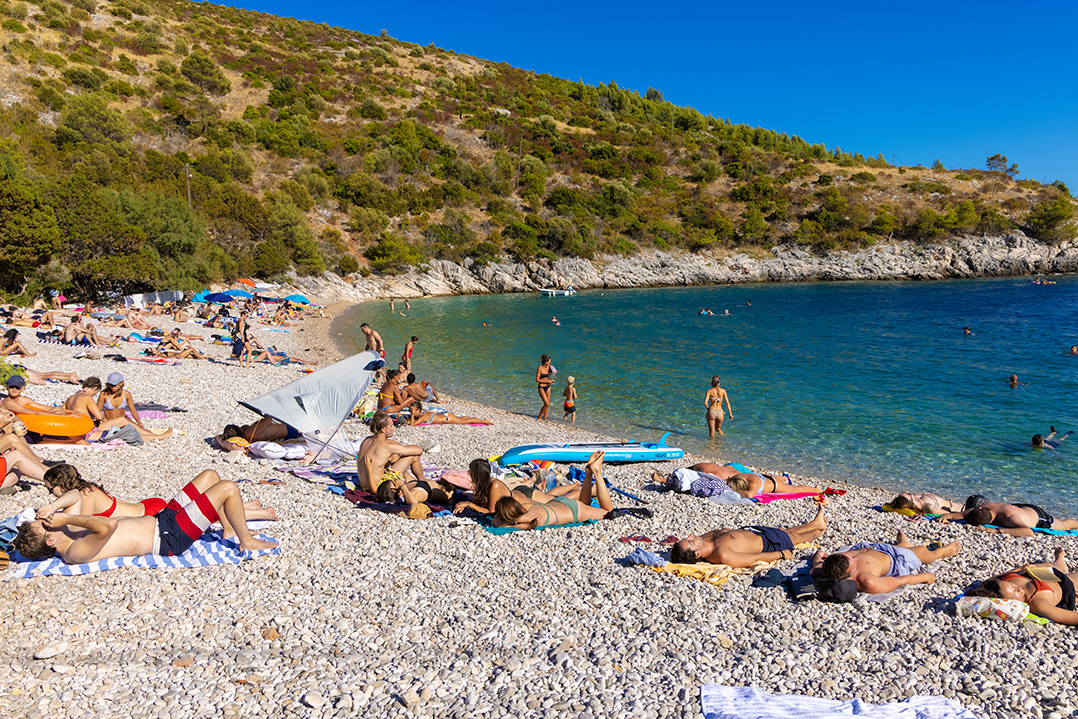
Even the populated Istrian Peninsula boasts several natural gems that captivate the hearts of nature lovers. Cape Kamenjak, a protected nature area, is renowned for its rocky bays and endless blue vistas that stretch into the horizon. The area’s rugged coastline contrasts starkly against the azure waters, creating a picturesque setting for adventurers and photographers alike.
Rocky beaches on the Adriatic in Croatia
Rocky beaches, comprising about 75% of the Croatian coast, offer natural beauty and convenience. For those seeking solitude, exploring beyond the nearest, often crowded beach can lead to discovering secluded spots or islands, each with its charm. From the natural area of Beritnica Beach on Pag Island, known for its barren landscapes, to the dramatic cliffs of Brseč in Istra, Croatia’s rocky beaches promise an unforgettable experience for every visitor. Any part of the Croatian coast can be considered a beach along the continuous stretch of the Adriatic Coast.
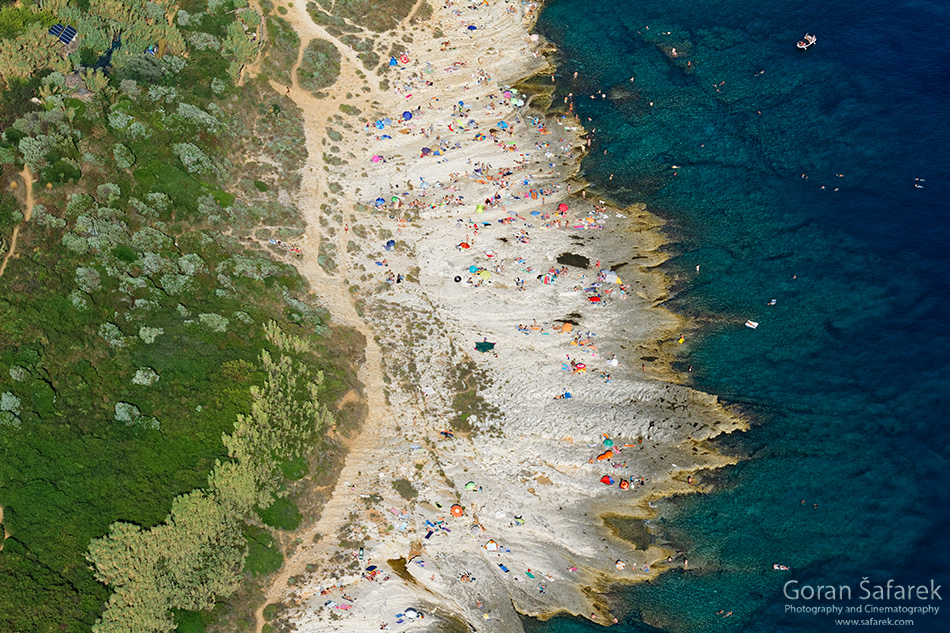
The Adriatic coast of Croatia is celebrated for its stunning rocky beaches, each offering a unique experience for travellers seeking adventure, relaxation, or a touch of naturism. Where the rugged landscape meets the crystal-clear waters of the Adriatic Sea. Rocky beaches provide a perfect backdrop for a variety of activities, from peaceful sunbathing on flat rocks to exploring the rich marine life through snorkelling.
The lack of sand renders the sea extraordinarily clear, so swimming and snorkelling are an experience unlike any other. Croatia’s coastline offers a multitude of spots that cater to both beginners and advanced enthusiasts. The sheer diversity of marine environments, from serene bays to dramatic underwater caves, ensures that every dive is a unique adventure.
Pebble beaches on the Adriatic in Croatia
Pebble beaches along the Adriatic coast in Croatia offer a unique blend of natural beauty and convenience, making them a favourite among families, adventure seekers, and those looking to relax by the crystal-clear waters. These beaches are typically found in small bays where the relentless cycles of waves and tides have eroded solid rock. The pebbles come in various shapes and sizes, ranging from coarse to occasionally perfect pebbles resembling pearls.
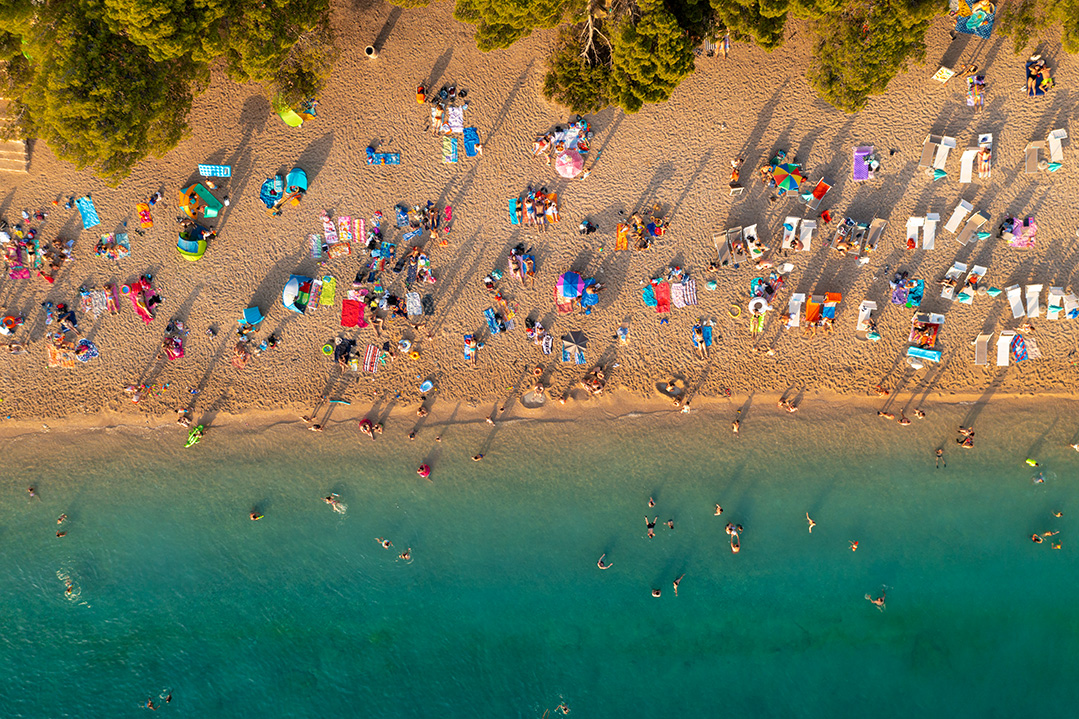
The exception is the island of Brač, which is renowned for its Zlatni Rat Beach, often highlighted for its dynamic shape that shifts with the wind and sea currents. Here, the gravel protrudes into the sea like a giant tongue, the tip constantly changing due to the currents.
Similarly, Makarska Riviera is a pebble-strewn paradise for marine life explorers. Its beaches stretch along the coast at the foothill of the mighty Biokovo Mountain. One example of a stunning pebble beach is Duba Beach, nestled in a secluded natural cove in a shade of pine and olive trees.
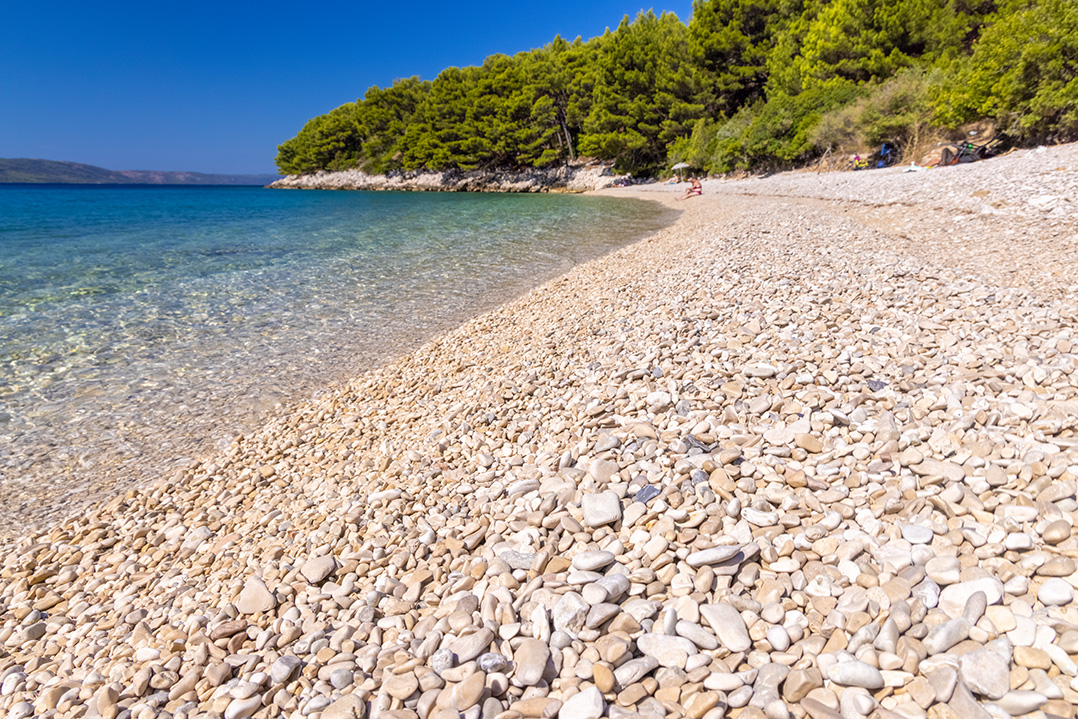
Most pebble beaches are flatter, so entering the sea is easier. Some pebble beaches are only accessible from the sea, protected by the rugged coastline, usually on the open sea facing sides of the islands.
Similarly, Dubovica Beach on Hvar is renowned for its natural ambience and traditional stone house. The beach’s clear waters and scenic surroundings make it a perfect spot for snorkelling and exploring the Adriatic’s marine life.
Sand beaches on the Adriatic in Croatia
The Adriatic beaches in Croatia are renowned for their diverse offerings. Still, the sandy beaches hold a special allure for many. These beaches, with their soft, fine sands and shallow, warm waters, make for perfect family vacation spots, offering a blend of relaxation and recreational activities. However, due to the karst geology, sand beaches are rare in the Adriatic and scattered along the coast. They are the most common in northern Dalmatia and Kvarner.
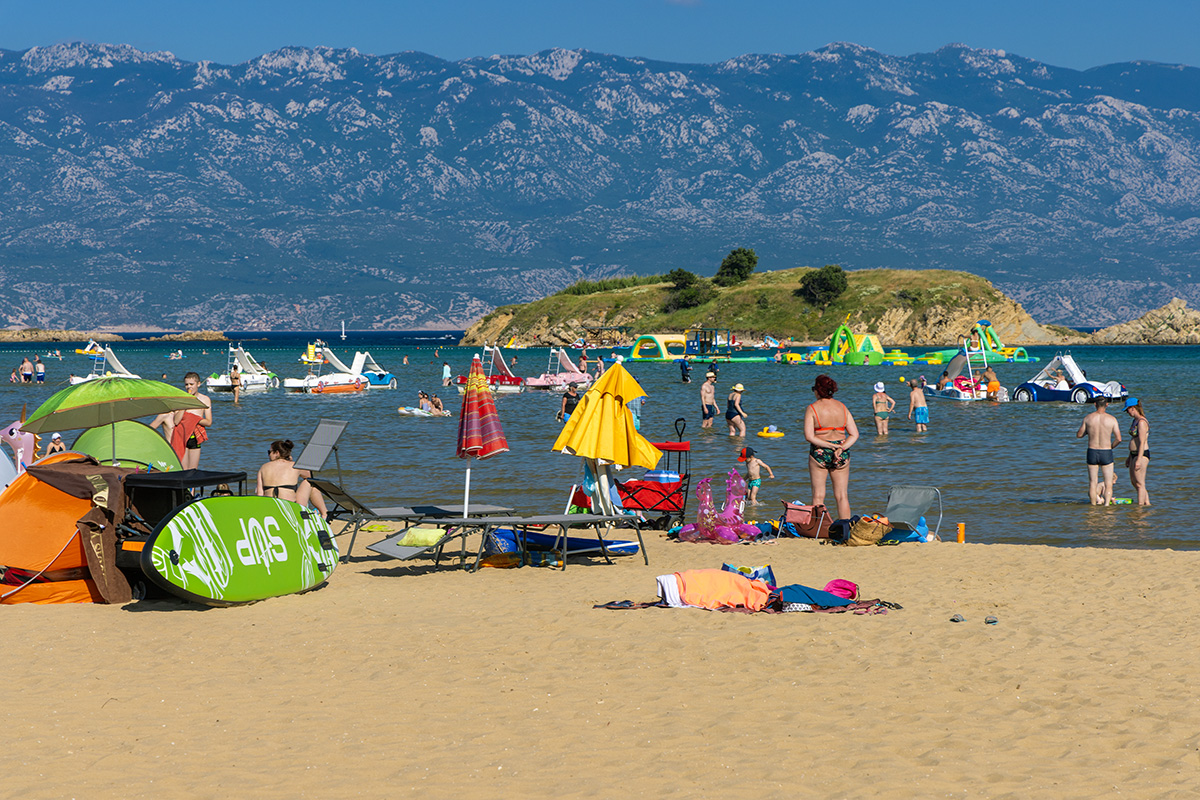
Among these, the island of Rab stands out with its Paradise Beach in Lopar Bay, a haven for families due to its shallow waters and extensive facilities, including bars, restaurants, and water sports activities. Similarly, Duboka Draga Beach on Vir Island and Sakarun Beach on Dugi Otok are celebrated for their beautiful sandy stretches and crystal-clear waters, ideal for small children and those looking for a serene beach experience.
Nin, on the Zadar Riviera, is home to the Nin Lagoon, also known as Queen’s Beach. It’s famous not just for its shallow, warm waters, perfect for young swimmers, but also for its medicinal mud, which adds a unique twist to your beach day.
Additionally, Medulin in southern Istria offers a 1km long sandy beach called Bijeca, equipped with water sports facilities, bars, and restaurants, ensuring a fun-filled day by the sea.
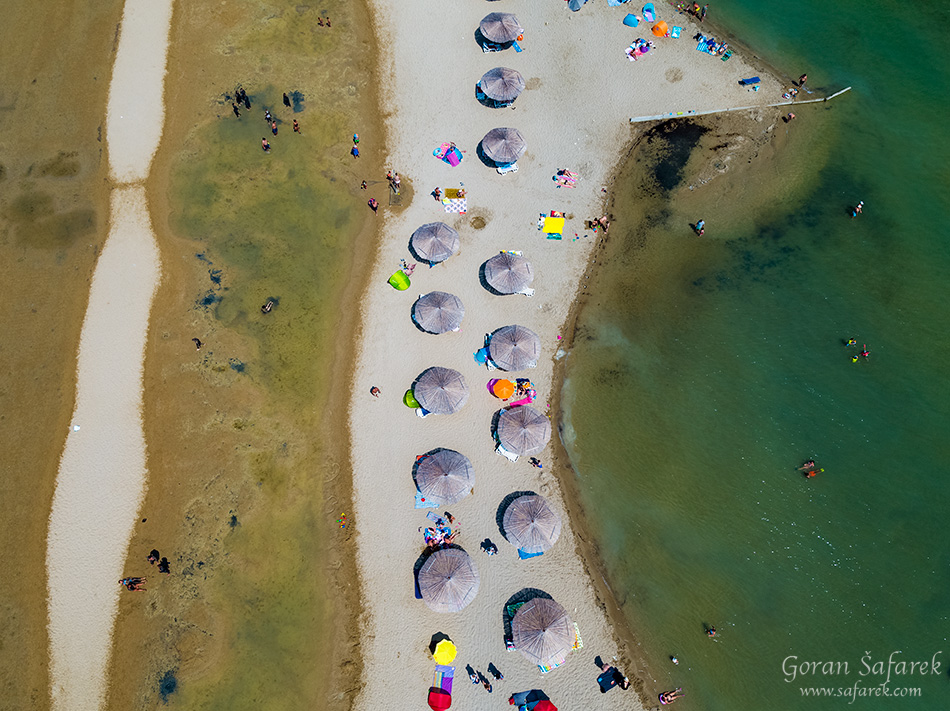
The Crikvenica Riviera and the islands of Krk and Hvar boast several beautiful sandy beaches. Manestra Bay, between Dramalj and the Kacjak peninsula, is renowned for its sandy stretch along the Kvarner region. At the same time, Mlaska Beach on Hvar island offers a large, 800 m-long beach with very fine sand, suitable for families.
The island of Mljet, with its stunning sandy beaches such in Saplunara, provides an idyllic setting for those looking to escape the crowds and enjoy the pristine nature of the Adriatic coast. With their shallow waters, fine sand, and ample facilities, these beaches cater to a wide range of preferences, ensuring a memorable beach experience for everyone.
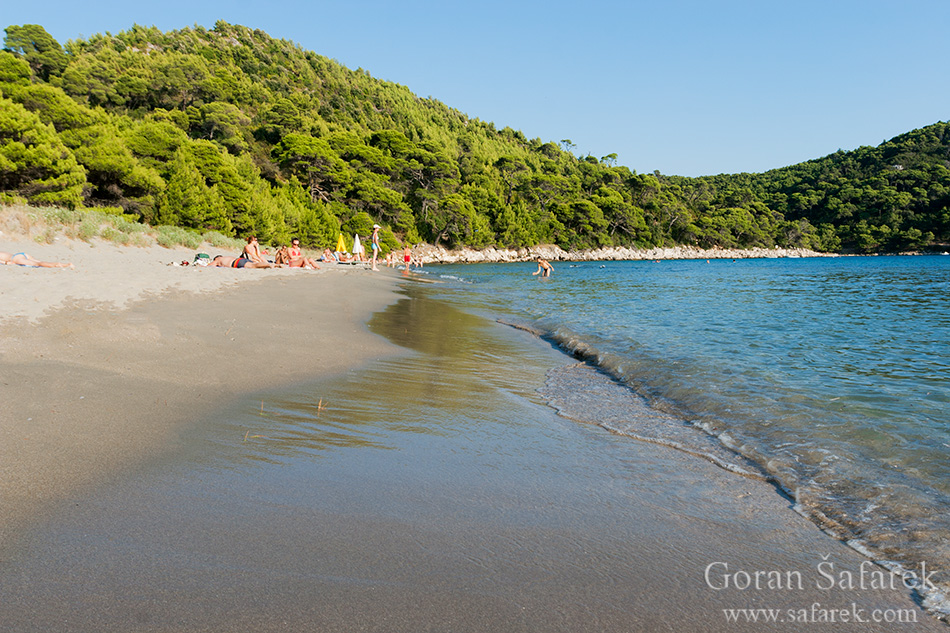
Urban beaches on the Adriatic in Croatia
Urban beaches on the Adriatic in Croatia blend the convenience of city amenities with the coastline’s natural beauty, offering visitors a unique experience. These beaches, made from pebbles and sand and often equipped with pathways and cement terraces, provide easy access to the sea, making them ideal for a leisurely day under the sun or engaging in water sports.
Banje Beach in Dubrovnik is a prime example of an urban beach combining stunning views of the Old Town and Lokrum Island with many activities for water sports enthusiasts. Its proximity to the city’s historical sites allows visitors to combine cultural exploration with beach relaxation.
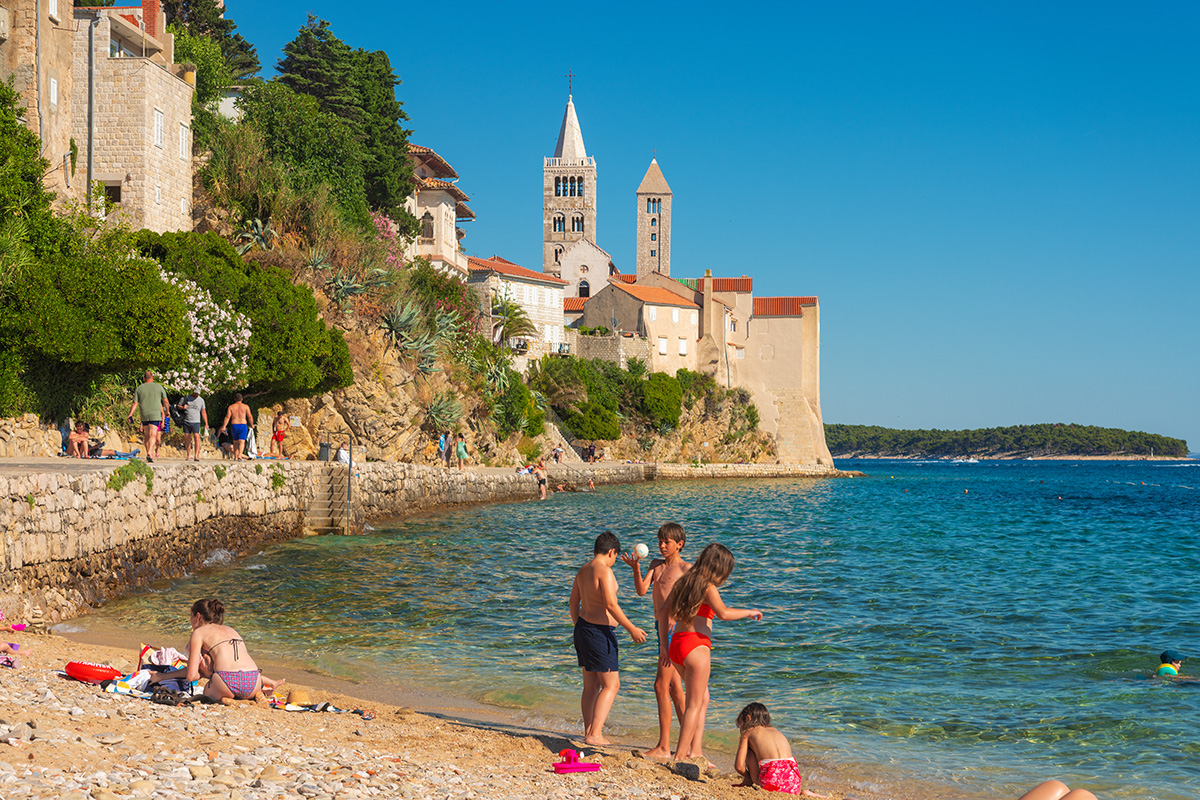
Further down the coast, Mala Raduča Beach in Primošten offers a kilometre-long stretch of pebbles and clear waters, surrounded by restaurants, bars, and shops, catering to sports enthusiasts and those looking for a lively beach atmosphere. Makarska Beach stands out for its natural setting, surrounded by pine and olive trees, offering a serene escape while still being close to urban conveniences.
The island of Murter‘s Slanica Beach is a hub of activity with its long shallow waters and abundant facilities, making it a popular choice among beachgoers.
Each of these and many other urban beaches in the Adriatic region of Croatia offer their own unique charm. They combine the ease of city life with the unspoiled beauty of the Croatian coast.
Family beaches on the Adriatic in Croatia
The Adriatic coast of Croatia is not just about its stunning landscapes and clear blue waters; it’s a paradise for families looking for the perfect beach holiday. The diversity of beaches, from rocky to sandy, ensures that there’s something for every family, whether you’re looking for adventure, relaxation, or a bit of both.
For instance, the sandy Čikat Bay in Lošinj Island is highly recommended for snorkelling with kids, offering gentle slopes into the sea and an underwater world that’s sure to captivate the young ones. Similarly, the Crikvenica Riviera, with beaches like Crni Molo in Crikvenica and Poli Mora beach in Selce, is known for its shallow waters, making it safe for children to play and enjoy the sea.
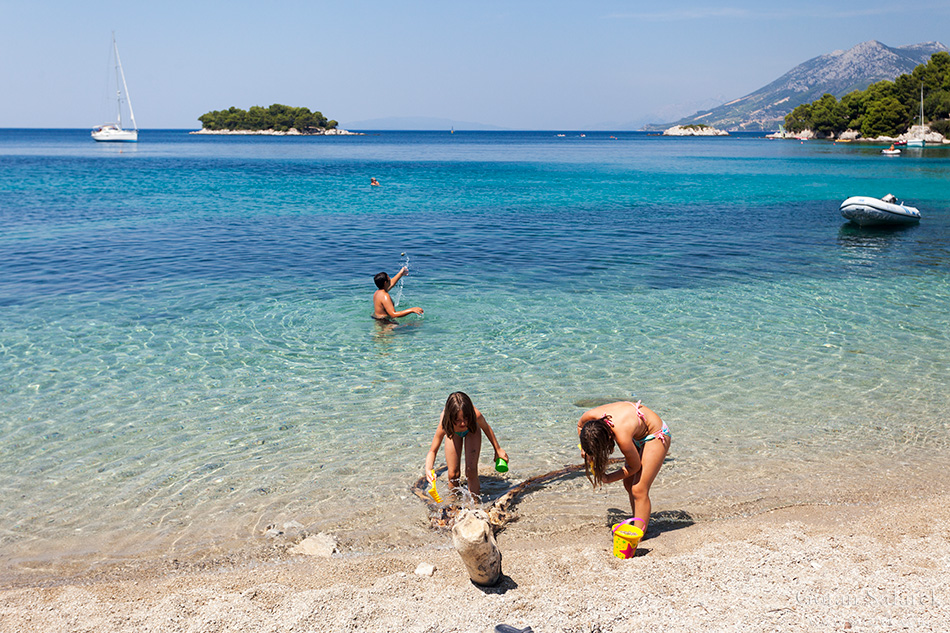
Each of these beaches, with its unique characteristics, ensures that families can find their ideal spot along Croatia’s Adriatic coast for a sun, sea, and sand holiday.
Party Beaches on the Adriatic in Croatia
On the other hand, Zrće Beach is a famous party beach on the island of Pag. The beach is perfect for swimming, sunbathing, and water sports such as jet skiing and parasailing. Zrće Beach attracts a young crowd of party-goers from all over Europe who enjoy the numerous nightclubs and music festivals there.
Sport and recreation beach activities on the Adriatic in Croatia
The Adriatic coast of Croatia is a playground for those who love to merge their beach holidays with a dash of adventure and sports. From the rocky beaches that offer a plethora of activities to the serene sandy shores perfect for family-friendly fun, there’s something for everyone
Famous Zlatni rat Beach is not just about its aesthetic appeal; it’s a hub for water sports enthusiasts, offering activities like windsurfing, jet-skiing, and volleyball, all under the comforting shade of pine trees.
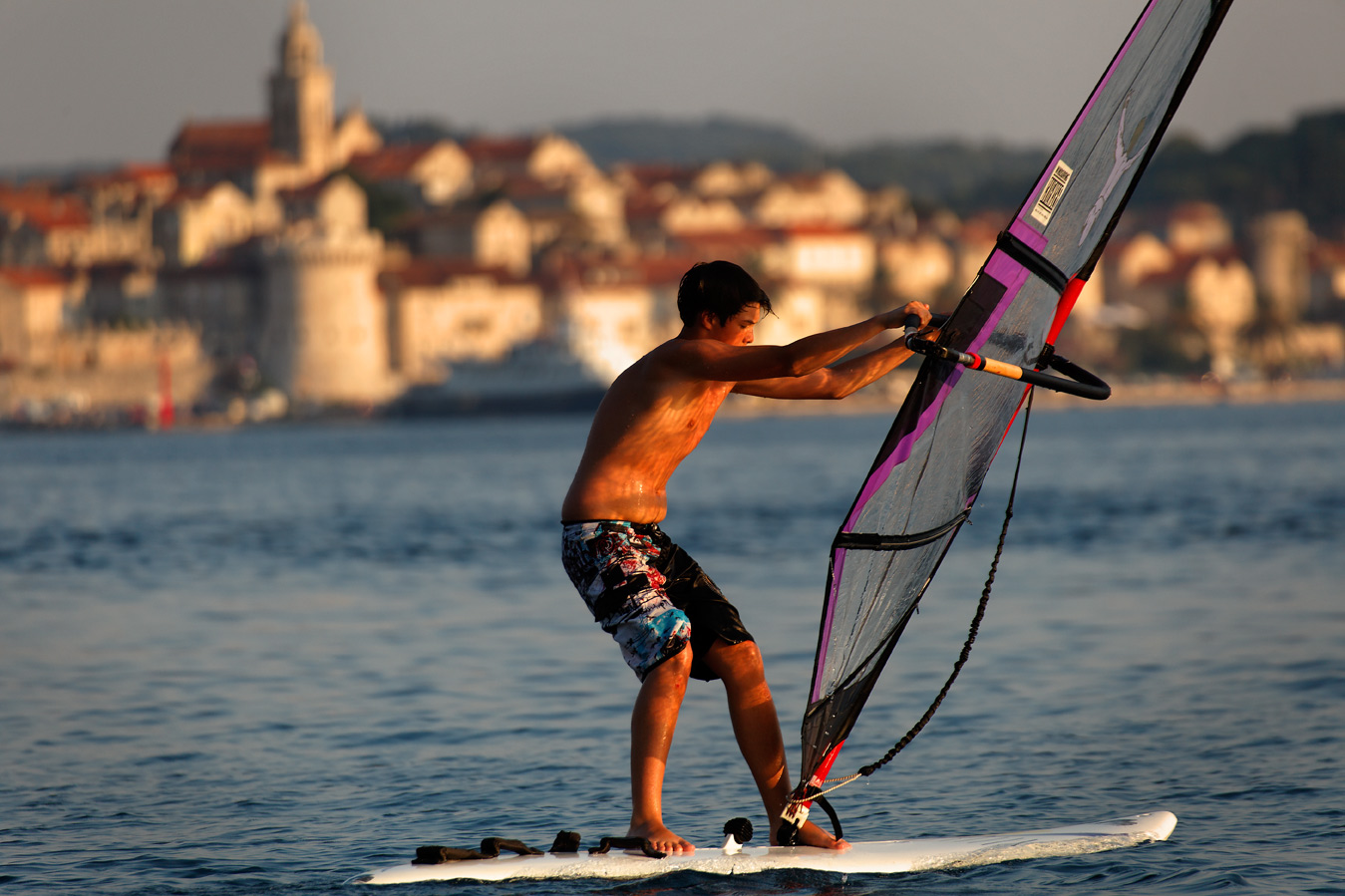
For those inclined towards surface water sports, Nin and Neretva Delta are unbeatable for kiteboarding. At the same time, Viganj is the go-to destination for windsurfing with a fantastic backdrop of Korčula town and Pelješac peninsula. Krk offers an adrenaline rush with wakeboarding. Sea kayaking and stand-up paddling are familiar scenes on many Croatian beaches.
Nudist beaches on the Adriatic in Croatia
Croatia’s Adriatic coast is a haven for those seeking the liberating experience of nudist beaches, where the ethos of ‘free body culture’ or FKK (Freikörperkultur) is celebrated. These beaches offer a mix of rocky, pebble, and sandy shores nestled in secluded coves or sprawling along the coast, providing a variety of natural settings for visitors to enjoy the sun and sea in total freedom. Croatia, as a very liberal country, is one of the best places for beach nudism in Europe.
Read our guide for nudist beaches in Croatia
Official nudist beaches are found all along the coast, usually in more secluded coves, and in nudist camps.
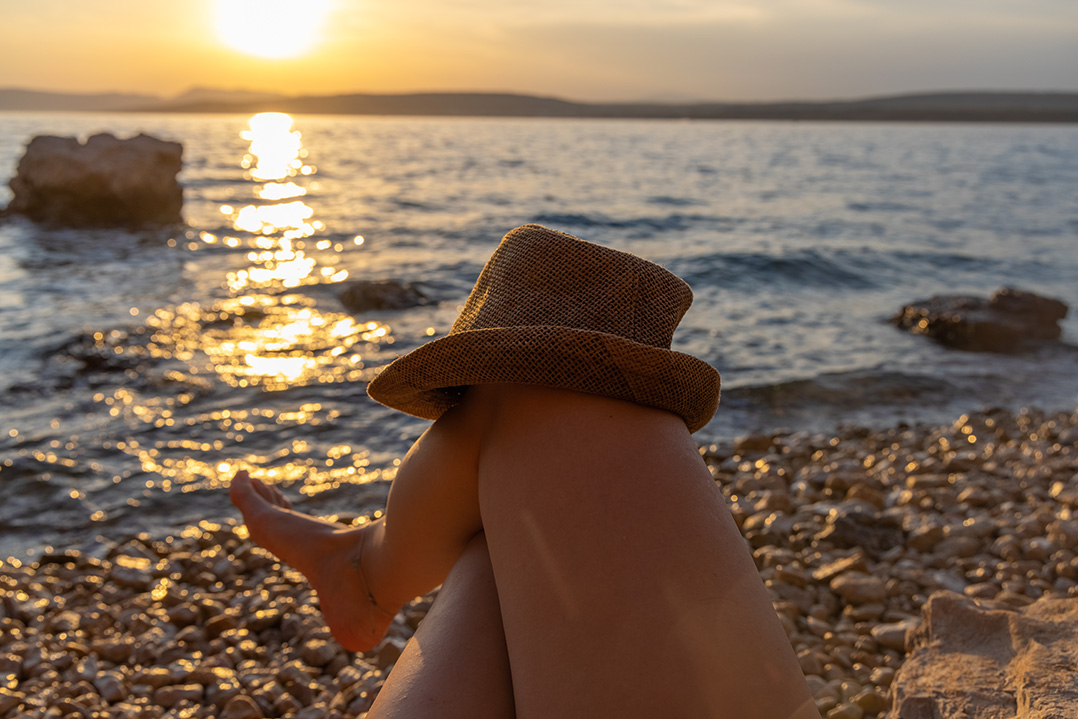
The istrian peninsula stands out as an naturalistic nudist haven with many camps. Meanwhile, on Rab Island, Sahara Beach and Kandarola Beach are renowned for their fine pebble shores and comprehensive amenities, including showers, bars, and even water slides, making them ideal for a comfortable day by the Adriatic Sea. Rab’s long history with naturism, dating back to when it was declared a nudist beach by the British royal family, adds a touch of historical allure to its beaches.
Best time to visit Adriatic Beaches
Determining the best time to visit the Adriatic beaches in Croatia hinges on personal preferences and the type of holiday experience one seeks. The high season, spanning from June to August, is when the beaches bustle with energy, the sea temperature is ideal for swimming, and the weather is predominantly hot and dry.
Read about the seasons in Croatia, and when to come
During these months, the sea temperature ranges from a comfortable 23°C to 27°C, while air temperatures hover between 25°C to 30°C, providing perfect conditions for sunbathing, swimming, and engaging in various water sports. The Adriatic Sea reaches its warmest in August, with an average temperature around 24 degrees Celsius, making it the prime time for those looking to spend extended periods in the water.
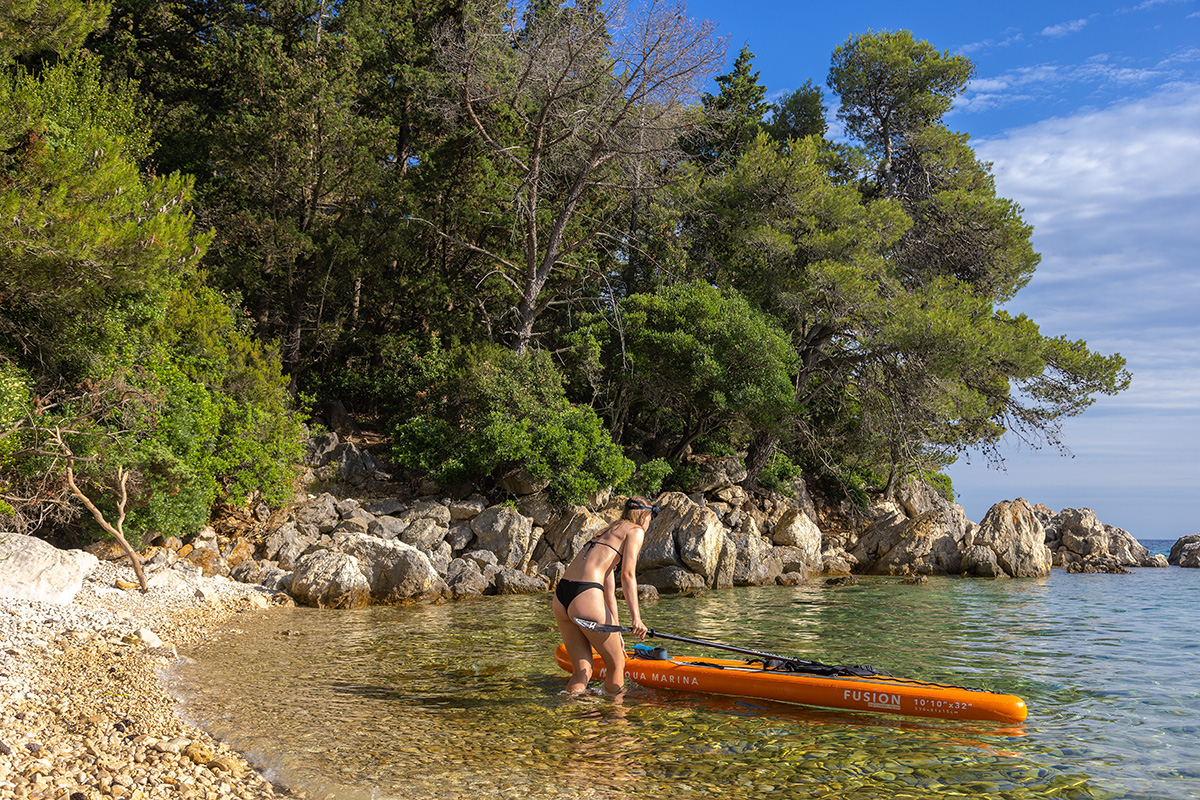
For visitors who prefer a more tranquil beach experience or cooler swimming conditions, the months of June and September are highly recommended. These months mark the beginning and the end of the swimming season, which generally lasts from June to September but can extend into May and October, depending on the year’s weather conditions.
During these shoulder months, the scorching heat of July and August has dissipated, yet the Adriatic Sea remains warm enough for swimming, around 25°C. The weather is comfortable, with 12 hours of light and eight hours of daylight every day, and occasional rains that rarely last long enough to disrupt plans.
Conclusion
Through this exploration of Croatia’s Adriatic coast, we have journeyed from the historical and cinematic allure of its rocky shores to the tranquil expanse of its sandy beaches, each offering a distinct slice of paradise for every visitor. The guide vividly captures the essence of Croatia’s diverse beaches, from secluded coves and vibrant urban sands to the liberating spaces of nudist beaches.
Drawing upon the myriad of activities available, from snorkelling in crystal-clear waters to embarking on cultural excursions, it is clear that the Adriatic coast caters to adventurers, families, and solo travellers alike, promising a holiday replete with beauty, excitement, and relaxation.
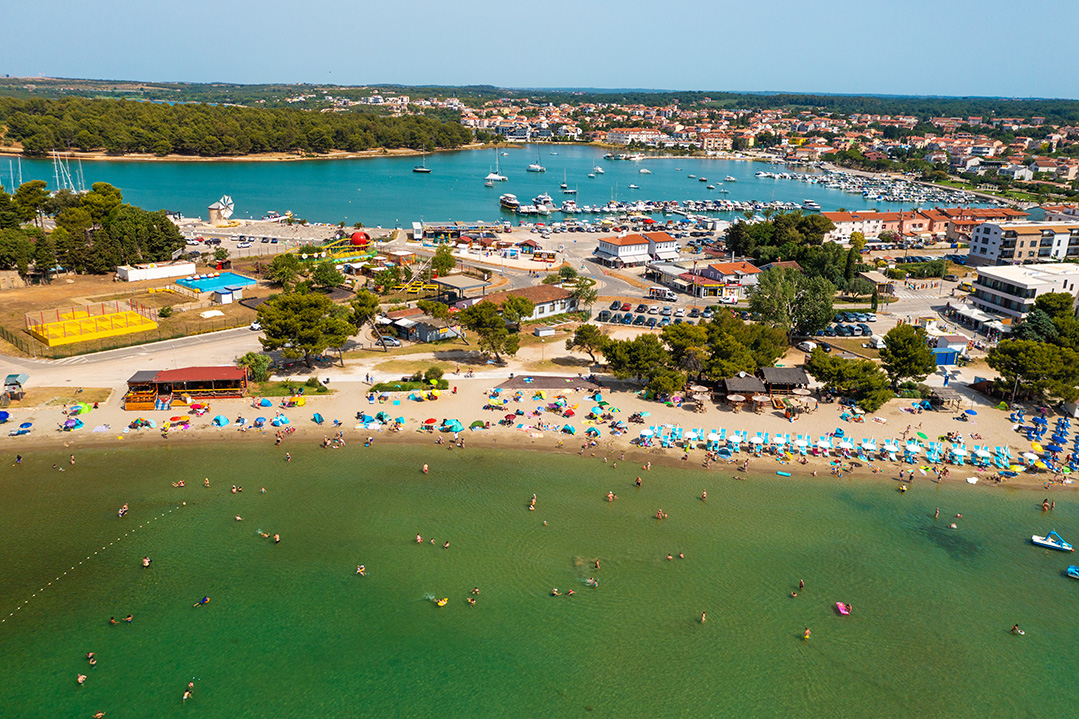
Whether looking for the tranquillity of a secluded beach or the exhilaration of a water sports adventure, Croatia’s Adriatic coast assures memories that linger long after the journey ends, beckoning travellers back to its enchanting shores.
